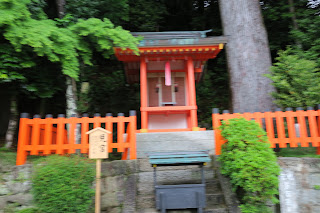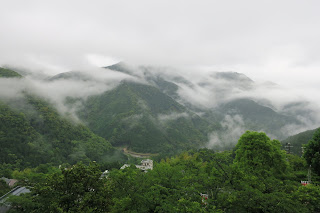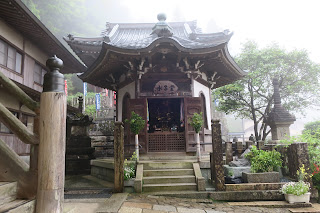Kumano Nachi Taisha is a Shinto shrine and part of the UNESCO-designated World
Heritage Sacred Sites and Pilgrimage Routes in the Kii Mountain Range of
Japan. The Kumano Kodo route connects it to other sites under the same
classification, which are primarily located in Wakayama Prefecture, Japan.
Kumano Nachi Taisha is an example of Buddhist and Shinto syncretism (Shinbutsu
shugo) nestled in the Kii Mountains, near Kii Katsuura, Japan. Cedar forests
surround the site. The 133-meter Nachi Waterfall, worshiped at the Hiryu
Shrine near Kumano Nachi Taisha, is believed to be inhabited by a kami called
Hiryu Gongen. Also, there is a sacred tree at this site, the Sacred Camphor
Tree, located between the Nachi Shrine (heiden) and Seigantoji temple.
|
Kumano Nachi Taisha map.
The shrine, consisting of six buildings at the top of 467 stone steps,
is situated in the Nachi mountains at a height of approximately 500m.
|
|
Big Tree of Kikai.
Halfway up the 467-step staircase, we can rest in the shade of the Big
Tree of Kikai.
|
|
Kanze'on-Bosatsu Buddha shrine.
A little further up, this time on the right side of the stairs, is this
shrine dedicated to Kannon.
-
Guanyin (Chinese: Kuan-yin; Japanese: Kannon; Korean: Gwan-eum;
Vietnamese: Quan Am) is a Bodhisattva associated with compassion. She
is the East Asian representation of Avalokitesvara.
-
See more at
Guanyin - Wikipedia.
|
|
First torii of Kumano Nachi Taisha (Ichi-no-Tori'i).
The function of a torii is to mark the entrance to a sacred space. For
this reason, the road leading to a Shinto shrine (sando) is
almost always straddled by one or more torii.
-
If the sando passes under multiple torii, the outer of them is
called ichi no torii (first torii).
-
See more at
Torii - Wikipedia.
|
|
Water ablution pavilion (Chozuya).
Chozu-ya or temizu-ya is a Shinto water ablution pavilion for a
ceremonial purification rite known as temizu or chozu
(lit. 'hand-water'). The pavilion contains a large water-filled basin
called a chozubachi ('hand water basin').
-
At shrines, these chozubachi are used by worshippers for washing their
left hands, right hands, mouth and finally the handle of the water
ladle to purify themselves before approaching the main Shinto shrine
or shaden.
-
This symbolic purification is normal before worship and all manned
shrines have this facility, as well as many Buddhist temples and some
new religious houses of worship.
-
See more at
Chōzuya - Wikipedia.
|
|
Tafuke Prince shrine (Tafuke-Oji).
-
The term "Ouji" used here does not stand for the general Japanese
meaning of "Prince", but refers to "A place to perform rituals on the
road to making a pilgrimage".
|
|
Tafuke Prince shrine, first torii and water ablution pavilion.
Tafuke Prince shrine (left), first torii (center) and water ablution
pavilion (right).
- Top-down view from the stairs.
|
|
Stairs from the First torii to the Sacred Horse shrine.
Stairs leading from the First torii (Ichi-no-Torii) to the Stable of the
Sacred Horse shrine (Shinmesha).
|
|
Stable of the Sacred Horse shrine (Shinmesha).
After the first torii and stairs, along the path toward the main shrine
area, is a stable that houses the sacred horse (shinme).
-
The horse is dedicated to the shrine to serve as a divine messenger
for the deity Kumano Musumi no Kami.
-
It was once common for Shinto shrines to keep sacred horses on the
grounds, but most discontinued the practice due to the extensive care
required.
- In modern times, only white horses are chosen to be the shinme.
-
The “duties” of the sacred horse include greeting shrine visitors and
participating in certain festivals and ceremonies.
|
|
Stairs from the Sacred Horse shrine to the main shrine area.
The stairway that leads from the Sacred Horse shrine to the main shrine
area is guarded by two lions, one on each side.
-
Guardian lions (Komainu), often called lion-dogs in English, are
statue pairs of lion-like creatures either guarding the entrance or
the honden, or inner shrine of many Japanese Shinto shrines or kept
inside the inner shrine itself, where they are not visible to the
public.
-
Meant to ward off evil spirits, modern komainu statues usually are
almost identical, but one has the mouth open, the other closed. The
two forms are called a-gyō (lit. '"a" shape') and un-gyō (lit. '"un"
shape') or referred to collectively as a-un.
-
The open mouth is pronouncing the first letter of the Sanskrit
alphabet, which is pronounced "a", while the closed one is uttering
the last letter, which is pronounced "um", to represent the beginning
and the end of all things. Together they form the sound Aum, a
syllable sacred in several religions like Hinduism, Buddhism, and
Jainism.
-
See more at
Komainu - Wikipedia.
|
|
Second torii gate and Main hall.
Finally, at the top of the stairs is the second tori gate (right) and
the main hall (centre). After the torii are the water pavilion and the
sacred tree.
|
|
Water ablution pavilion (Chozuya) with dragons.
The Chinese dragon, also known as the loong, long or lung, is a
legendary creature in Chinese mythology, Chinese folklore, and Chinese
culture at large.
-
Chinese dragons have many animal-like forms such as turtles and fish,
but are most commonly depicted as snake-like with four legs.
-
They traditionally symbolize potent and auspicious powers,
particularly control over water.
-
The dragon is also a symbol of power, strength, and good luck for
people who are worthy of it in East Asian culture.
-
In Chinese culture, excellent and outstanding people are compared to a
dragon, while incapable people with no achievements are compared to
other, disesteemed creatures, such as a worm.
-
The impression of dragons in a large number of Asian countries has
been influenced by Chinese culture, such as in Korea, Vietnam, and
Japan.
-
See more at
Chinese dragon - Wikipedia.
|
|
Kii Mountains (Kii Sanchi).
After the water pavilion we have a wonderful view of the Kii Mountains.
-
Kii Mountains (Kii Sanchi) is a mountainous region covering most of
the Kii Peninsula. They lie in Wakayama, Nara, and Mie prefectures.
The mountains are arranged roughly northeast to southwest.
-
See more at
Kii Mountains - Wikipedia.
|
|
Kumano Nachi Taisha main hall.
The main deity of Kumano Nachi Shrine is Kumano Musumi no Kami, who is
identified as the Buddhist deity, Senju Kannon, or the Shinto god,
Izanami.
-
Just like the other Kumano Sanzan shrines, Kumano Nachi Shrine also
enshrines twelve other gods, as well as Onamuchi.
|
|
Kagura ritual dance.
Kagura ("god-entertainment") is a type of Shinto ritual ceremonial
dance. The term is a contraction of the phrase
kami no kura ("seat of god"), indicating the presence of gods
(kami) in the practice.
-
One major function of kagura is chinkon (purifying and shaking
the spirit), involving a procession-trance process.
-
Usually a female shaman will perform the dance and obtain the oracle
from the god—in the setting, the dancer herself turns into god during
the performance.
-
See more at
Kagura - Wikipedia.
|
|
A tea after the ritual.
After the ritual dance, the priestess offers us a cup of tea with two
biscuits, one biscuit is white (male) and the other biscuit is red
(female).
|
|
Visit to the inner sanctuary (Honden).
After the ceremony we were privileged to participate in a private visit
to the most sacred place in the sanctuary.
-
The honden is the most sacred building at a Shinto shrine,
intended purely for the use of the enshrined kami, usually
symbolized by a mirror.
-
The building is normally in the rear of the shrine and closed to the
general public.
-
Physically, the honden is the heart of the shrine complex,
connected to the rest of the shrine but usually raised above it, and
protected from public access by a fence called tamagaki.
-
See more at
Honden - Wikipedia.
|
|
Three-legged crow stone (Karasuishi).
The three-legged (or tripedal) crow is a mythological creature in
various mythologies and arts of East Asia. It is believed to inhabit and
represent the Sun.
-
In Japanese mythology, this flying creature is a raven or a jungle
crow called Yatagarasu (eight-span crow) and the appearance of the
great bird is construed as evidence of the will of Heaven or divine
intervention in human affairs.
- Yatagarasu as a crow-god is a symbol specifically of guidance.
-
In the Three Great Shrines of Kumano (Kumano Sanzan), Yatagarasu is
worshiped as a servant of the Susanoo-no-Mikoto, the Great God of
Kumano, and is also a symbol of Kumano.
-
It is said that the Yatagarasu, who guided the first emperor before
his accession to the throne, changed into a crow stone
(karasuishi) and rested on Mt. Nachi. The painting called
Nachiyama Palace Mandala, which depicts Mt. Nachi in the Muromachi
period, also depicts this crow stone (karasuishi) in the same
place as today, surrounded by the main shrine.
-
See more at
Yatagarasu - Wikipedia.
|
|
Votive plaques (Ema).
Ema (lit. 'picture-horse') are small wooden plaques, common to Japan, in
which Shinto and Buddhist worshippers write prayers or wishes. Ema are
left hanging up at the shrine, where the kami (spirits or gods) are
believed to receive them.
-
Typically 15 cm (5.9 in) wide and 9 cm (3.5 in) tall, they often carry
images or are shaped like animals, or symbols from the zodiac, Shinto,
or the particular shrine or temple.
-
Once inscribed with a wish, ema are hung at the shrine until they are
ritually burned at special events, symbolic of the liberation of the
wish from the writer.
-
See more at
Ema (Shinto) - Wikipedia.
|
|
Shrine maiden (Miko).
A miko, or shrine maiden, is a young priestess who works at a Shinto
shrine.
-
Miko were once likely seen as shamans, but are understood in modern
Japanese culture to be an institutionalized role in daily life,
trained to perform tasks, ranging from sacred cleansing to performing
the sacred Kagura dance.
-
The traditional attire of a miko is a pair of red
hakama (divided, pleated trousers), a white kosode (a
predecessor of the kimono), and some white or red hair ribbons. In
Shinto, the color white symbolizes purity. The garment put over the
kosode during Kagura dances is called a chihaya.
-
See more at
Miko - Wikipedia.
|
|
Sacred Camphor Tree (Nachi no kusunoki).
Also, there is a sacred tree at this site, the Sacred Camphor Tree,
located between the Nachi Shrine (heiden) and Seigantoji temple.
-
It is 850 years old and is said to have been planted by
Taira-no-Shigemori (1138-1179).
-
The straw rope (shimenawa) and paper flags show that this tree
has been sanctified as a kami.
-
The tree is alive with moss and ferns and other small plants growing
on its ancient limbs.
-
It is possible to enter the base of the tree, where there is a small
altar for making offerings, and come out above ground level.
|
|
Passing through the womb of Kusunoki Shrine.
The Sacred Camphor Tree (Nachi no kusunoki) has a natural hollow in its
trunk means you can squeeze through inside to listen to its ancient
breath.
|
|
Leaving the Shinto area and entering the Buddhist area.
|
|
Shuoshi Mizuhara haiku monument.
Shuoshi Mizuhara (October 9, 1892 – July 17, 1981) was a Japanese haiku
poet and physician.
-
He published his first haiku collection, Katsushika, in 1930. The
volume is now recognized by critics as a key work in the modernization
of haiku.
-
The next year, he wrote a romantic manifesto that served as his exit
from Hototogisu, "Truth in Nature and Truth in Literature", where he
wrote: «If the whole aim of haiku writing were to grasp 'truth in
nature,' the poet would need no assiduous study to gain new knowledge,
no constant endeavour to enrich his mind. All he would have to do
would be to roam about with a notebook in his pocket, following the
shadow of a cloud.»
-
See more at
Shūōshi Mizuhara - Wikipedia.
|
|
Seigantoji Temple.
Seiganto-ji, Temple of Crossing the Blue Shore, is a Tendai Buddhist
temple.
-
According to a legend, it was founded by the priest Ragyo Shonin, a
monk from India.
-
The temple was purposely built near Nachi Falls, where it may have
previously been a site of nature worship.
-
Seiganto-ji is part of the Kumano Sanzan shrine complex, and as such
can be considered one of the few jingū-ji (shrine temples)
still in existence after the forcible separation of Shinto and
Buddhism operated by the Japanese government during the Meiji
restoration.
- Inside it looks more like a commercial store than a temple.
-
See more at
Seiganto-ji - Wikipedia.
|
|
Life-Extending Water (Enmei no mizu).
The "Life-Extending Water" is located next to the main hall.
- A small amount of water is flowing out of five bamboo tubes.
|
|
Mountain Gate (Sanmon).
The origins of the name "sanmen" are debated.
-
One theory is that "Shanmen" takes its literal meaning of "Mountain
Gate", because temples were traditionally built in forested mountain
areas where Chan monks could seclude away from secular life.
-
Another suggests that during various episodes of suppression of
Buddhism in Chinese history, monks moved their monasteries deep into
the mountains, and later built gates at the foot of the mountain to
guide pilgrims to the temples.
-
A further theory is that "Shanmen" is a corruption of "Sanmen", or
"Three Gates", referring to the "three gateways" to liberations in the
Dharma - the "Kongmen" (emptiness liberation), "wuxiangmen"
(no-aspects liberation) and "wuyuanmen" (desireless liberation).
-
See more at
Shanmen - Wikipedia.
|
|
Mizukodo shrine.
The Japanese term mizuko (literally, “water child”) refers to a
deceased baby, infant, or fetus. This includes stillborn and miscarried
children as well as those who died by abortion, and in some cases also
applies to babies that die shortly after birth.
-
A funerary rite, called mizuko kuyō, is often performed on
behalf of these children, and Japan has many shrines honoring
mizuko – mostly in combination with statues of Jizo, a kind
incarnation of the Buddha who is considred the patron and protector of
mizuko.
-
This Mizuko Kuyo Kannon shrine is small, and visitors often overlook
it in favor of larger, more clearly identified structures like the
bell, the pagoda, and the massive worship hall. However, this Kannon
has great meaning to families of mizuko, many of whom come here
to pray, leave offerings, and seek solace for the pain of a loss that
is nearly unimaginable to people who have never lost a child. It’s
also fairly unique among mizuko shrines, because so many are dedicated
to Jizo.
-
See more at
Mizuko kuyō - Wikipedia.
|
|
Daikokuten shrine.
Daikokuten is a syncretic Japanese deity of fortune and wealth.
-
Daikokuten originated from Mahakala, the buddhist version of the Hindu
deity Shiva, conflated with the native Shinto god Okuninushi.
-
Upon being introduced to Japan via the esoteric Tendai and Shingon
sects, Mahakala (as 'Daikokuten') gradually transformed into a jovial,
beneficent figure as his positive qualities (such as being the
purveyor of wealth and fertility) increasingly came to the fore -
mostly at the expense of his darker traits.
-
See more at
Daikokuten - Wikipedia.
|
See also
Source
Location
Fudarakusan-ji Temple
Kumano Hayatama Taisha Shrine
Kumano Pilgrimage Route
Shugendo Religion
Kumano Hongu Taisha Shrine








































































